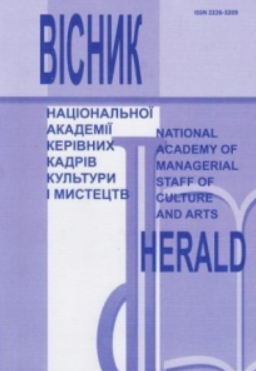ЕВОЛЮЦІЯ ЄВРОПЕЙСЬКОГО КАСКАДЕРСЬКОГО МИСТЕЦТВА (50–70-ті рр. ХХ ст.)
THE EVOLUTION OF EUROPEAN STUNT ART (50–70S OF THE TWENTIETH CENTURY)
Author(s): Nazar MayborodaSubject(s): Post-War period (1950 - 1989), Film / Cinema / Cinematography, History of Art
Published by: Національна академія керівних кадрів культури і мистецтв
Keywords: stunt art; French cinema; films "cloaks and swords"; actors; stuntmen; tricks;
Summary/Abstract: The purpose of the article is to identify the specifics of the formation and development of stunt art in French cinema of the 1950-1970s; analyze the contribution to the process of formation in the European film industry stunt as a profession of French actors and performers of film stunts. Methodology. The scientific provisions of the article are reasoned at the level of the totality of general scientific methods of cognition and approaches of modern art history. The historical, analytical and typological methods were applied, which contributed to determining the specifics of the professionalization process of stunt art in the French film industry in the 1950-1970s, as well as the typological features of cinema stunts of the leading French stuntmen; a method of comparative analysis (to identify the characteristic signs of stunt activities before and after professionalization) and other. Scientific novelty. For the first time in Russian art criticism, the process of development and professionalization of stunt art in European cinema of the 1950-1970s has been studied. on the example of the evolution of French historical stunt scenes (films ―cloak and sword‖), adventure and detective films; reviewed and analyzed the professional activities of C. Carlier, R. Julien, J. Delamard and other French stuntmen of this period; revealed the influence of American stunt performers, the specifics of the development of French stunt art, as well as characterized the evolution of stunt techniques, the use of existing ones and the development of new safety methods for their implementation. Conclusions. The content and nature of professional stunt activities in the context of cinematic art are non-static, since its dynamism is determined by the stunt status in the continuous qualification system. The stunt man is the stunt developer, stunt coordinator (stunt director), and the head of the stunt troupe. In the 50–70s. XX century in French cinema, a complex process of professionalization of stunt art took place, the motivation of which was the need to assimilate professional knowledge, skills, abilities, and expand the experience of professional activity. The specifics of the French movie stunts by C. Carlier, R. Julien, J. Delamard, and I. Cipher are manifested in originality, exposure to the viewer with a degree of risk, and a specially refined aesthetics.
Journal: Вісник Національної академії керівних кадрів культури і мистецтв
- Issue Year: 2021
- Issue No: 1
- Page Range: 226-231
- Page Count: 6
- Language: Ukrainian

